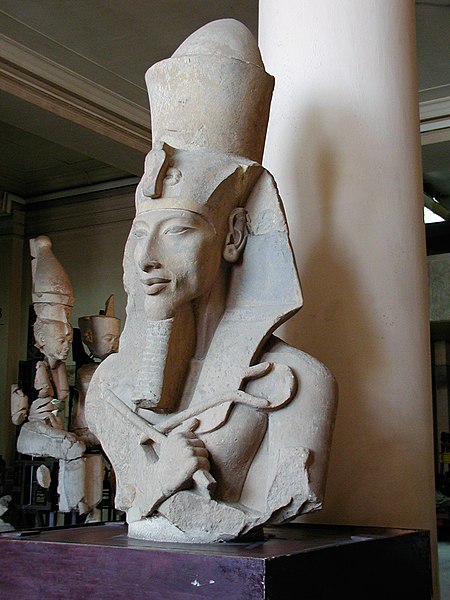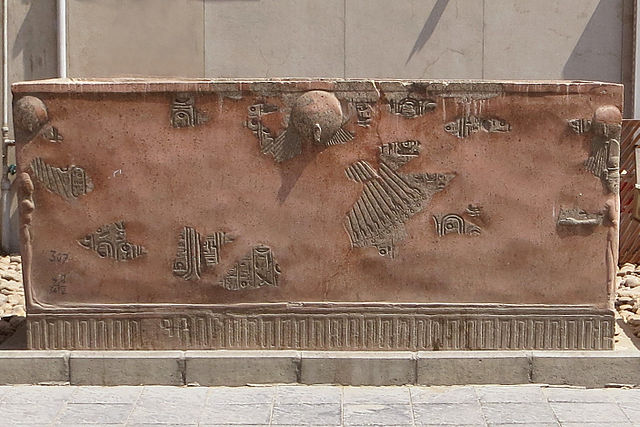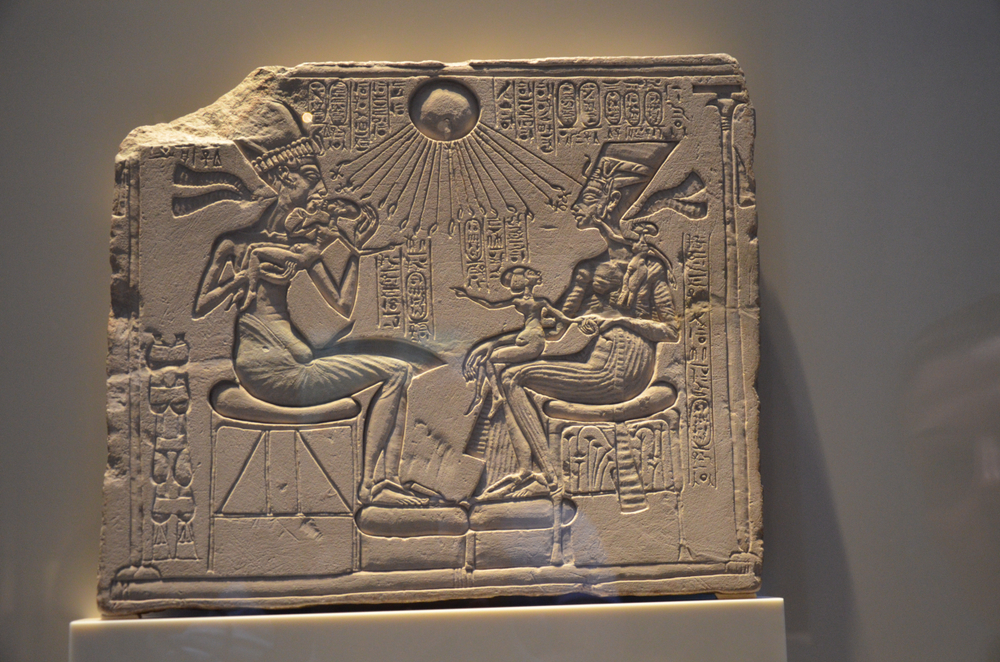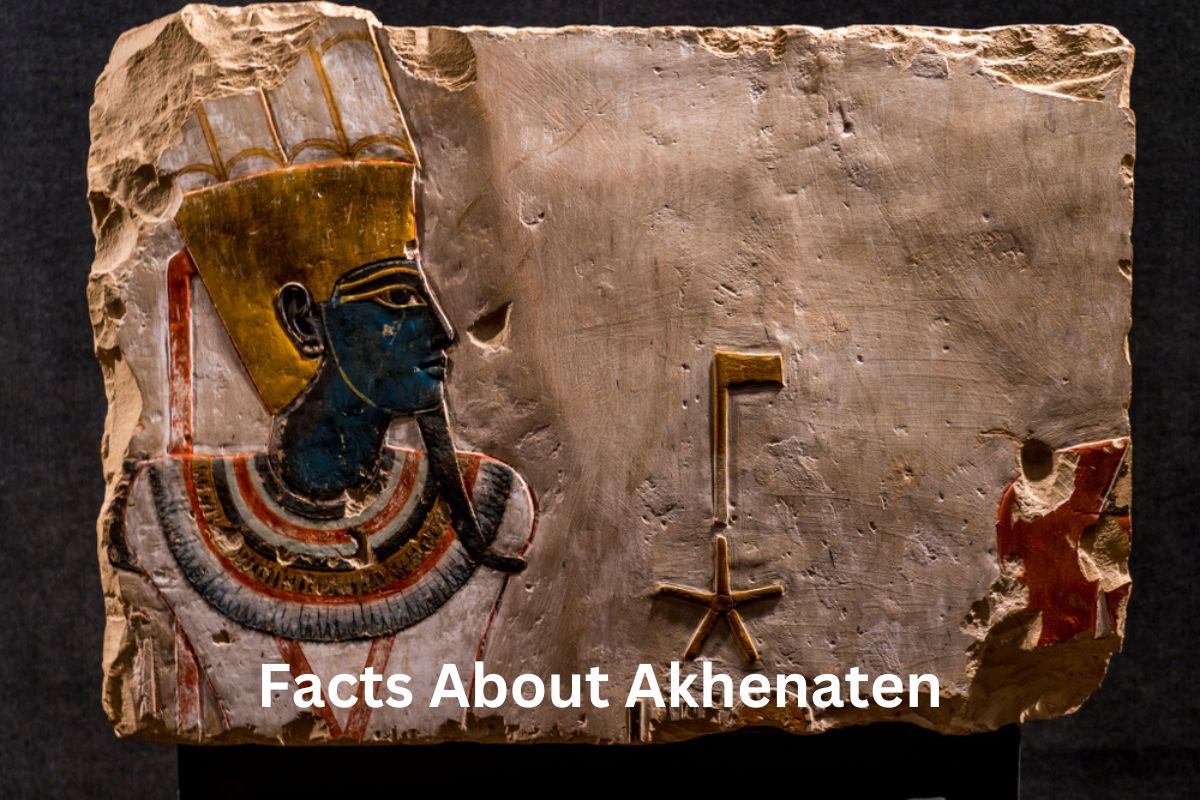Akhenaten, originally named Amenhotep IV, was an ancient Egyptian pharaoh who reigned during the 18th Dynasty of the New Kingdom period, from approximately 1353 to 1336 BCE.
He is known for his religious revolution, where he abandoned the traditional polytheistic worship of multiple gods in favor of the exclusive worship of the sun-disk deity, the Aten. Akhenaten and his queen, Nefertiti, were considered the intermediaries between the Aten and the people.
He moved the capital of Egypt from Thebes to a new city called Akhetaten (Amarna), which was built to reflect his religious ideology. Akhenaten introduced the Amarna art style, characterized by exaggerated and naturalistic depictions of the human body.
After his death, his reforms were largely reversed, and traditional gods and practices were restored. Akhenaten’s reign and his religious revolution left a lasting impact on Egyptian history, and he continues to be an intriguing figure studied by historians and archaeologists.
Akhenaten Facts
1. Akhenaten was an ancient Egyptian pharaoh who reigned during the 18th Dynasty of the New Kingdom
Akhenaten, born as Amenhotep IV, ascended to the throne of Egypt during the 18th Dynasty of the New Kingdom period.
Also Read: Akhenaten Accomplishments
His exact birth date is uncertain, but it is believed to be around 1380 BCE. His reign lasted for approximately 17 years, from 1353 to 1336 BCE.

2. He was originally named Amenhotep IV
Amenhotep IV initially ruled under the name Amenhotep IV, which was a common practice for Egyptian pharaohs who wished to honor the god Amun.
However, early in his reign, he changed his name to Akhenaten, signifying a profound shift in religious beliefs and practices.
3. Akhenaten is known for introducing a religious revolution in ancient Egypt
Akhenaten’s most notable achievement was his religious revolution, which brought about a radical transformation in the Egyptian religious landscape.
He abandoned the traditional polytheistic worship of numerous gods, including the popular Amun-Ra, and introduced a monotheistic approach centered on the Aten, a previously lesser-known sun-disk deity. Akhenaten proclaimed the Aten as the supreme god, emphasizing its role as the creator and sustainer of all life.
This religious revolution was unprecedented in ancient Egypt, as it challenged centuries of religious traditions and practices. Akhenaten saw himself not only as the ruler of Egypt but also as the earthly representative of the Aten.
His new religious ideology sought to establish a direct and personal connection between the pharaoh and the god, bypassing the traditional priesthood and temples associated with other gods.
4. The Aten, according to Akhenaten’s beliefs, was considered not just a sun god but also a universal force of creation and life
The Aten, the sun-disk deity worshipped by Akhenaten, was conceived as a universal force of creation and life. Akhenaten believed that the Aten was not just a local or limited deity but the sole god responsible for the existence of everything in the universe.
This marked a departure from the traditional Egyptian pantheon, where multiple gods and goddesses held specific domains and responsibilities. Akhenaten and his queen, Nefertiti, were regarded as the physical manifestations of the Aten on Earth, serving as intermediaries between the god and the people.

5. Under Akhenaten’s rule, the capital of Egypt was moved from Thebes to a new city called Akhetaten
In order to solidify his religious revolution, Akhenaten founded a new capital city called Akhetaten, known today as Amarna. The city was strategically located in Middle Egypt and was designed and constructed from scratch to reflect Akhenaten’s religious ideology.
The layout of Amarna differed from traditional Egyptian cities, with wide, straight streets and open-air temples dedicated solely to the Aten. The city also housed the royal palace and administrative buildings, becoming the center of political and religious life during Akhenaten’s reign.
6. Akhenaten promoted a new artistic style known as the Amarna style
The Amarna period introduced a distinct artistic style known as the Amarna style or the Amarna art revolution. This art style was characterized by a departure from the conventional artistic norms of ancient Egypt.
The representations of human figures in Amarna art displayed unique features, including elongated and exaggerated body proportions, slim limbs, and elongated faces with prominent cheekbones, full lips, and heavy-lidded eyes.
The emphasis was on capturing a sense of movement and naturalism, showcasing a departure from the idealized and static portrayals of earlier periods.
7. During his reign, Akhenaten suppressed the worship of other gods, and their temples and statues were defaced or destroyed
As part of his religious revolution, Akhenaten actively suppressed the worship of other gods throughout Egypt. Temples dedicated to traditional deities were either closed down or repurposed for the worship of the Aten.
Statues and depictions of other gods were defaced or destroyed, with inscriptions and names of deities erased from monuments. This iconoclastic approach aimed to eliminate the worship of gods other than the Aten and establish monotheism as the sole religious practice in Egypt.
The eradication of traditional religious practices caused significant disruption and controversy within Egyptian society, as the traditional gods held deep cultural and religious significance for the population.

8. Akhenaten was married to Nefertiti, who played a prominent role during his reign
Akhenaten was married to Nefertiti, who played a prominent role during his reign. Nefertiti is often depicted in artwork alongside Akhenaten, and she held a position of influence and authority.
Some evidence suggests that she may have even co-ruled alongside Akhenaten, as her name is found on official documents and she was depicted in a manner typically reserved for pharaohs. Nefertiti was known for her beauty and is one of the most iconic figures of ancient Egypt.
9. The couple had six known daughters, including the famous Tutankhamun’s wife, Ankhesenamun
Akhenaten and Nefertiti had six known daughters:
- Meritaten
- Meketaten
- Ankhesenpaaten
- Neferneferuaten Tasherit
- Neferneferure
- Setepenre
The daughters were often depicted in artistic reliefs and tomb scenes, where they were shown receiving affection and attention from their parents.
These depictions suggest that Akhenaten and Nefertiti had a close and loving relationship with their children.
10. Akhenaten’s religious reforms were met with resistance, and after his death, there was a backlash against his ideas
After Akhenaten’s death, there was a strong backlash against his religious reforms. His successor, Tutankhamun, abandoned the worship of the Aten and reinstated the traditional polytheistic religion.
The names of the old gods were restored, and their temples and religious practices were revived. This period of reversal is often referred to as the Amarna Restoration.
Tutankhamun’s reign marked a return to the religious and cultural traditions that were prevalent before Akhenaten’s monotheistic revolution, and it is believed that the young pharaoh’s advisors played a significant role in steering Egypt back to its traditional religious beliefs.
Despite the restoration, Akhenaten’s religious revolution left a lasting impact on Egyptian history, and his reign continues to be a subject of fascination and study.
11. The exact cause of Akhenaten’s death is unknown, and there are various theories
The cause of Akhenaten’s death remains uncertain, and historians and experts have put forward several theories based on the available evidence and historical context. However, due to limited information, none of these theories can be confirmed definitively. Some of the proposed theories include:
- Natural Causes: It is possible that Akhenaten died of natural causes, such as illness or old age. However, without any conclusive evidence, it is difficult to determine the specific ailment or condition that might have led to his demise.
- Assassination: Another theory suggests that Akhenaten may have been assassinated. The religious revolution he initiated disrupted traditional power structures and religious institutions, leading to potential opposition and resentment. Some speculate that powerful individuals or factions may have conspired to eliminate him in order to restore the traditional religious order.
- Inheritance Issues: Succession disputes and power struggles were not uncommon in ancient Egyptian history. Some theories propose that Akhenaten’s death might have been linked to conflicts over the line of succession. These disputes could have been a result of his unconventional religious reforms or political rivalries within the royal court.
- Religious Backlash: It is possible that after Akhenaten’s death, there was a backlash against his religious reforms. The restoration of the traditional gods under Tutankhamun may indicate a desire to distance Egypt from the perceived heresy of Akhenaten’s monotheistic worship of the Aten. In this scenario, Akhenaten’s death could have been a catalyst for a rejection of his religious ideology.
- Disease or Epidemic: Some historians speculate that a widespread disease or epidemic could have played a role in Akhenaten’s death. Egypt, like other ancient civilizations, was vulnerable to infectious diseases, and an epidemic could have affected the population, including the royal family.
It is important to note that these theories are speculative and lack conclusive evidence. The limited historical records and fragmented nature of the evidence make it challenging to determine the exact circumstances surrounding Akhenaten’s death.
The mystery surrounding his demise adds to the intrigue and fascination surrounding his reign and the Amarna period.
12. Akhenaten’s reign and the religious revolution he initiated had a significant impact on Egyptian history
Akhenaten’s reign and his religious revolution had a profound impact on Egyptian history and culture. The religious reforms he introduced challenged the established religious institutions and disrupted the traditional pantheon of gods that had been revered for centuries.
The suppression of other gods and the exclusive focus on the Aten reshaped the religious landscape of Egypt during his reign. The changes in religious practices, temple worship, and artistic styles brought about by Akhenaten were unique in Egyptian history.
13. Akhenaten’s legacy is mostly remembered for his religious reforms and his role in introducing monotheism to Egypt
After Akhenaten’s death, his religious reforms were swiftly reversed during the reign of his successor, Tutankhamun. The Amarna period was considered a controversial and tumultuous time, and the restoration of the traditional gods and religious practices aimed to stabilize the religious and social order.
Tutankhamun, along with his advisors, worked to undo the changes made by Akhenaten, reinstating the old gods, reopening temples, and reestablishing the priesthoods. The iconoclasm of the Amarna period resulted in the destruction and defacement of many artistic and religious artifacts, leaving behind fragmented evidence of the religious revolution.
